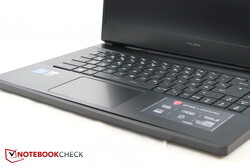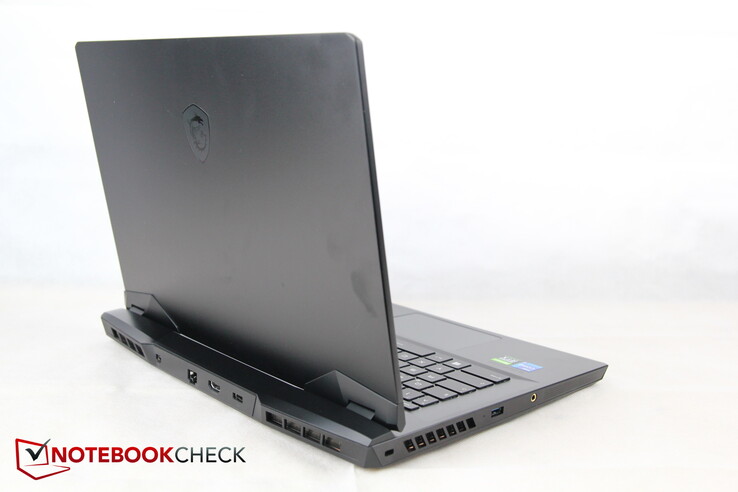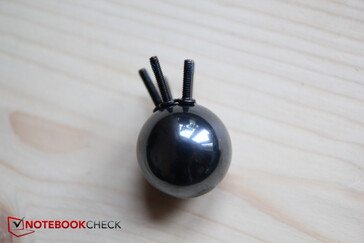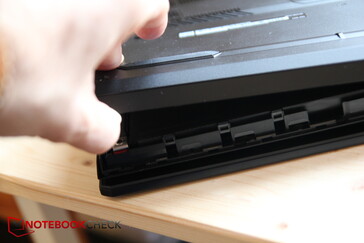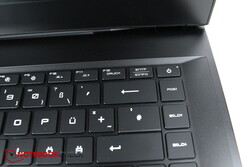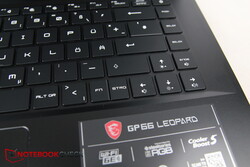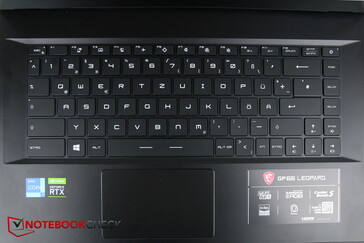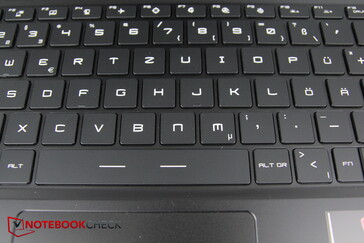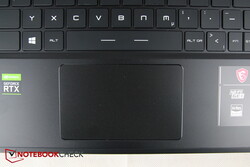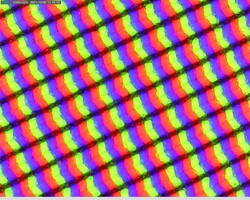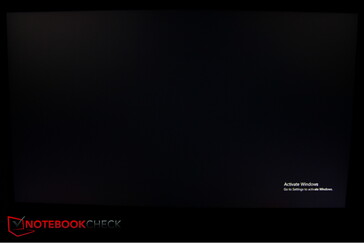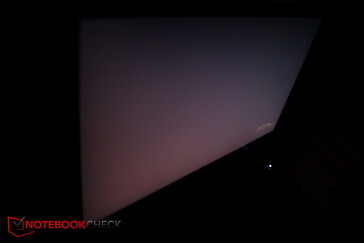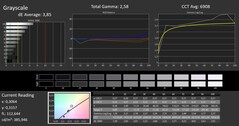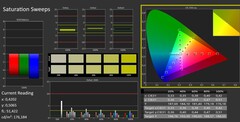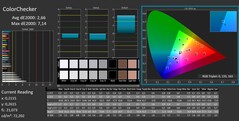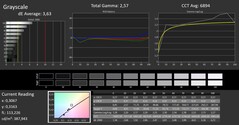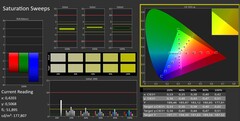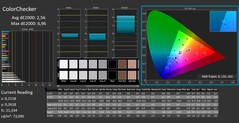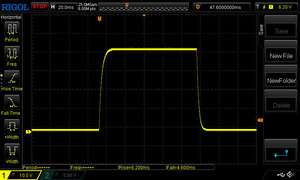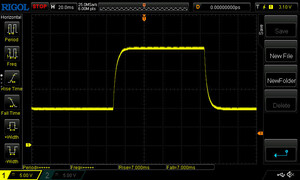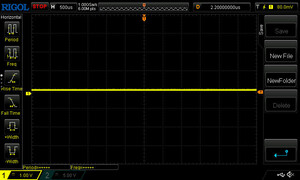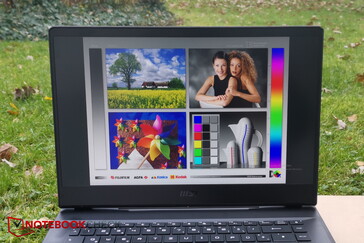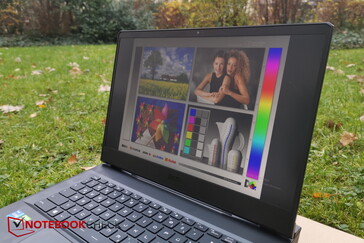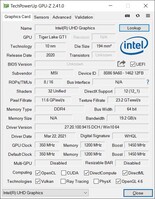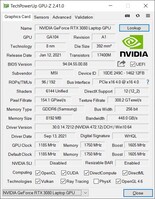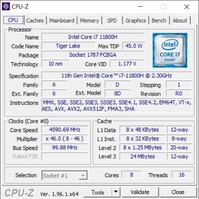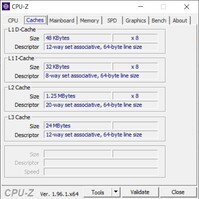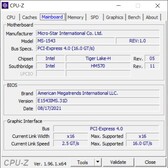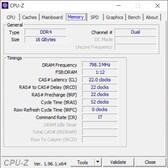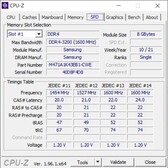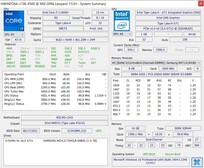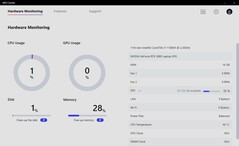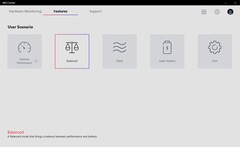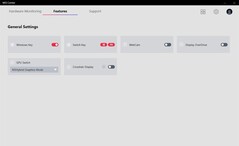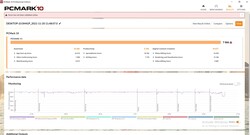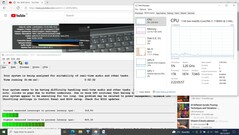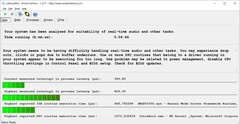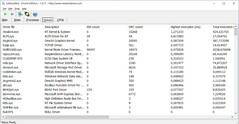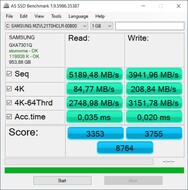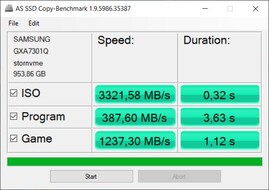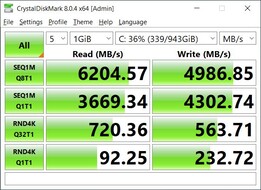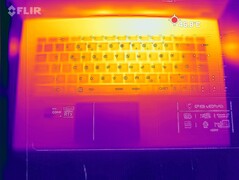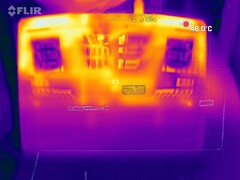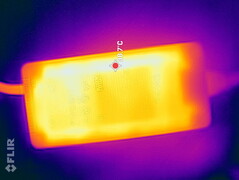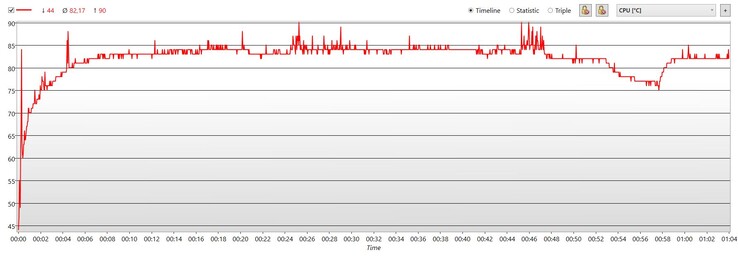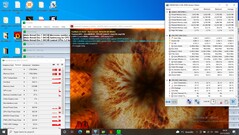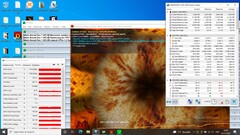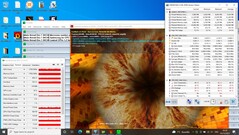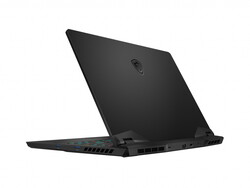Recensione dell'economico MSI GP66 Leopard 11UH: Gamer con RTX 3080 per meno di 2.000 euro

In aprile abbiamo recensito il predecessore MSI GP66 Leopard 10UG con CPU Comet Lake e abbiamo lodato il case ridisegnato. Il più recente GP66 Leopard 11UH è ora equipaggiato con una CPU Tiger Lake e anche il case è cambiato. Ma la cosa migliore è che il potente gamer può già essere acquistato per meno di 2.000 euro in configurazione con RTX 3080!
Il GP66 11UH è anche disponibile con un display QHD o RTX 3070 come alternativa; il nostro modello di prova è dotato di un veloce display Full HD.
L'MSI è apparentemente uno dei portatili da gioco più economici con RTX 3080, quindi non è facile trovare una competizione adeguata in questa fascia di prezzo. Ecco perché abbiamo usato per il confronto anche modelli un po' più costosi (fino a +500 euro) qui:Aorus 15P YD, il ASUS ROG Strix Scar 15, il Schenker XMG Neo 15 così come il considerevolmente più costoso Alienware m15 R6
Possible competitors in comparison
Punteggio | Data | Modello | Peso | Altezza | Dimensione | Risoluzione | Prezzo |
|---|---|---|---|---|---|---|---|
| 85.4 % v7 (old) | 12/2021 | MSI GP66 Leopard 11UH-028 i7-11800H, GeForce RTX 3080 Laptop GPU | 2.3 kg | 23.4 mm | 15.60" | 1920x1080 | |
| 84.2 % v7 (old) | 04/2021 | MSI GP66 Leopard 10UG i7-10870H, GeForce RTX 3070 Laptop GPU | 2.3 kg | 23.4 mm | 15.60" | 1920x1080 | |
| 86.4 % v7 (old) | 06/2021 | Aorus 15P YD i7-11800H, GeForce RTX 3080 Laptop GPU | 2.2 kg | 27 mm | 15.60" | 1920x1080 | |
| 86.3 % v7 (old) | 07/2021 | Asus ROG Strix Scar 15 G533QS R9 5900HX, GeForce RTX 3080 Laptop GPU | 2.3 kg | 27.2 mm | 15.60" | 2560x1440 | |
| 87 % v7 (old) | 06/2021 | Schenker XMG Neo 15 Tiger Lake i7-11800H, GeForce RTX 3080 Laptop GPU | 2.2 kg | 26 mm | 15.60" | 2560x1440 | |
| 86.1 % v7 (old) | 11/2021 | Alienware m15 R6, i7-11800H RTX 3080 i7-11800H, GeForce RTX 3080 Laptop GPU | 2.5 kg | 22.85 mm | 15.60" | 1920x1080 |
I nostri Top 10
» Top 10 Portatili Multimedia
» Top 10 Portatili Gaming
» Top 10 Portatili Gaming Leggeri
» Top 10 Portatili da Ufficio e Business economici
» Top 10 Portatili Premium da Ufficio/Business
» Top 10 Portatili sotto i 300 Euro
» Top 10 Portatili sotto i 500 Euro
» Top 10 dei Portatili Workstation
» Top 10 Subnotebooks
» Top 10 Ultrabooks
» Top 10 Convertibili
» Top 10 Tablets
» Top 10 Tablets Windows
» Top 10 Smartphones
Caso - I leggeri difetti di fabbricazione di MSI
L'involucro stesso rimane abbastanza simile, ma ci sono alcuni cambiamenti cruciali nelle porte (vedi sotto). Il coperchio del display e la base sono fatti di metallo scuro e liscio, mentre il fondo è ancora in plastica. Sul retro, il sistema di raffreddamento si estende, aumentando la profondità del portatile, simile all'Alienware
Il coperchio è sorprendentemente robusto, così come la base in teoria. Tuttavia, il nostro campione di prova ha qualche problema: quando premiamo la base a sinistra del touchpad, quest'ultimo si solleva dal touchpad e appaiono grandi spazi vuoti - questo è probabilmente un motivo per cui il touchpad fa rumore
In generale, la base sembra essere collegata solo abbastanza debolmente alla superficie, e anche il bordo anteriore si stacca molto rapidamente, come si può vedere anche nella foto. Questo dovrebbe favorire la manutenzione, ma d'altra parte non fa davvero una buona impressione in termini di qualità costruttiva. La costruzione stessa sembra molto robusta però, quindi dovrebbe essere ok sull'unità non difettosa.
Il GP66 è più profondo della maggior parte dei suoi rivali a causa del suo sistema di raffreddamento sporgente. Così, è molto simile all'Alienware, che è più profondo di altri 5 mm. Fortunatamente, non è pesante come quest'ultimo, ma alla pari con il resto della concorrenza. A parte questo, è uno dei dispositivi più sottili nel confronto. Di nuovo, solo il nuovo Alienware è un po' più sottile.
Caratteristiche - Onestamente MSI, niente USB-C?
Rispetto al suo predecessore, il GP66 10UG, MSI ha abbandonato la porta MiniDP in favore di una porta USB-C. Con l'attuale GP66 11UH, MSI fa un passo indietro e riporta la Mini DisplayPort, che è una mossa gradita. Ma il produttore elimina anche la porta USB-C! Così, il GP66 Leopard è l'unico portatile moderno senza una porta USB-C! Non sappiamo perché MSI ha fatto questo, dal momento che una porta USB-C è diventata lo standard assoluto al giorno d'oggi. Quindi, come effetto collaterale, il portatile ha solo tre porte USB. Non c'è anche un lettore SD.
Le poche porte rimanenti sono ben distribuite sui tre lati, cioè a sinistra, a destra e sul retro del case. MSI deve davvero essere lodata qui, dato che c'è molto spazio tra le varie porte, che almeno mette le cose in prospettiva un po' in vista della scarsa varietà di opzioni. Tutti i cavi potenzialmente spessi (HDMI, DP, LAN, alimentazione) sono instradati sul retro, e ci sono solo USB-A e la porta per le cuffie sui lati - molto bene
Comunicazione
MSI sostituisce l'Intel AX201 con un Killer Wi-Fi 6E AX1675 con supporto Bluetooth 5.2. Questo non rende il Wi-Fi molto più veloce. Anche se è nella gamma dei gigabit, è al di sotto del potenziale del modulo. Soprattutto la curva di ricezione ha una pendenza verso il basso, ma la potenza di trasmissione è abbastanza costante.
Webcam
Una webcam HD standard fornisce un'immagine accettabile nel migliore dei casi in Zoom, Teams e altre app per conferenze. L'immagine appare slavata anche in buona luce, e le deviazioni di colore sono abbastanza pronunciate soprattutto nelle gamme di colore rosso e verde.
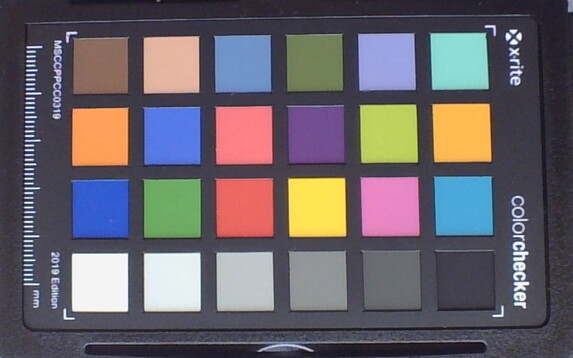
Sicurezza
Una porta Kensington è a bordo, così come il TPM. Tuttavia, non c'è uno scanner di impronte digitali o altre tecnologie di sicurezza - il che è accettabile per un portatile da gioco.
Manutenzione
La piastra di base è fissata da almeno 10 viti Phillips (1 più corta di tutte le altre) e vari fermi. E anche se il bordo anteriore del nostro modello era già parzialmente staccato prima, la manutenzione si è rivelata più complicata del previsto.
Il bordo anteriore si è staccato bene, ma i lati e il bordo posteriore no. Specialmente nella zona della presa delle cuffie, la piastra di base era ancora così saldamente bloccata (non direttamente sul bordo, ma all'interno) che abbiamo dovuto interrompere il tentativo di apertura nonostante l'attrezzo a leva, per paura di danneggiare la sottile piastra di plastica. Anche il bordo posteriore non ha ceduto. Le viti nascoste non avrebbero dovuto essere il problema, almeno sul lato.
La costruzione interna dovrebbe essere simile alla MSI GP66 Leopard 10UG (vedi sezione manutenzione), ma anche l'apertura è stata problematica
Accessori e garanzia
A parte l'alimentatore, non ci sono altri accessori nella scatola. Nota: MSI spedisce il GP66 Leopard senza sistema operativo, ma vari negozi dovrebbero includere una licenza Windows.
MSI offre una garanzia di 2 anni con servizio di ritiro e restituzione.
Dispositivi di input - Buona tastiera, il touchpad fa rumore
Tastiera
Nonostante le sue dimensioni di 15,6 pollici, il Leopard non ha un NumPad. D'altra parte, questo assicura che tutti i tasti siano abbastanza grandi e anche ben distanziati. Le scritte sono grandi e facili da leggere, anche se il font selezionato è un po' insolito, il che dovrebbe esplicitamente piacere ai giocatori. Il tasto di accensione è parte della tastiera e si trova nell'angolo in alto a destra. Può essere attivato involontariamente durante l'elaborazione del testo a causa della vicinanza di "insert" e "pos1"
La corsa è abbastanza breve, ma il feedback è ancora nitido. Il rumore di battitura è molto moderato, solo la barra spaziatrice è minimamente più forte. Nel complesso, digitare sul GP66 è divertente e veloce.
MSI risolve una cosa molto poco convenzionale: il tasto "fn" così importante non è a sinistra, ma a destra e condivide il suo posto con il tasto Ctrl destro. Da un lato, questo significa che devi pensare due volte e le combinazioni di tasti sono a volte piuttosto imbarazzanti perché o non puoi usare entrambe le mani per combinazioni di tasti molto separate o devi premere il secondo tasto con la mano sinistra. Il tasto è anche molto stretto, il che è particolarmente sfavorevole dato che di solito viene premuto con il pollice destro. Almeno è possibile scambiare la funzione del tasto fn con il tasto Windows nell'MSI Center.
In questo contesto, c'è una caratteristica interessante con una debolezza: la tastiera ha una retroilluminazione a 3 stadi. Quando il tasto fn è premuto, l'illuminazione di tutti gli altri tasti è temporaneamente spenta e solo le funzioni speciali dei tasti F, cioè i tasti con cui il tasto fn può essere combinato, si illuminano di rosso. Questa caratteristica ha però uno svantaggio, perché se cambiamo il livello di illuminazione della retroilluminazione, non vediamo immediatamente l'effetto di questo cambiamento, perché i tasti speciali che si illuminano di rosso non cambiano il livello di illuminazione, a differenza degli altri tasti.
Touchpad
Il touchpad misura circa 10,5 per 6,5 cm e ha dei pulsanti interni a scatto. Le capacità di scorrimento della superficie sono buone, ma chiaramente vacilla durante i movimenti lenti o le dita bagnate. Il pad è anche piuttosto impreciso negli angoli inferiori.
Come menzionato all'inizio, il touchpad del nostro modello di prova sferraglia quando lo si tocca leggermente con il dito. Questo è abbastanza fastidioso e anche abbastanza rumoroso quando si vogliono innescare dei click con un tocco del dito.
Il clic dei tasti integrati è abbastanza lento, soprattutto i doppi clic si sentono inutilmente faticosi, che si preferisce innescare con un tocco del dito, dove il rumore sferragliante viene di nuovo alla luce. Nel complesso, il touchpad, a differenza della tastiera, non fa la migliore figura.
Visualizza
MSI usa un pannello IPS Full HD opaco di LG Display con 144 Hz. È lo stesso pannello del Schenker XMG Apex 15 NH57E. La sua luminosità media di circa 360 nits è la più alta tra i confronti, e la sua distribuzione dell'87% è decente. In alternativa, il GP66 è disponibile anche con un pannello QHD (2560 x 1440 pixel).
Il valore del nero è troppo alto, motivo per cui il contrasto non produce tassi massimi, ma è ancora paragonabile alla concorrenza. Solo lo Schenker XMG Neo è chiaramente migliore qui. Quando si guarda il display di lato con un'immagine nera, si può vedere chiaramente il forte bagliore dello sfondo. Il valore del nero migliora naturalmente con una luminosità ridotta.
Il sanguinamento dello schermo è appena significativo nel nostro modello di test, la griglia dei pixel è un po' granulosa a causa della superficie opaca. I tempi di risposta del pannello sono ok, il PWM non è utilizzato.
| |||||||||||||||||||||||||
Distribuzione della luminosità: 87 %
Al centro con la batteria: 390 cd/m²
Contrasto: 951:1 (Nero: 0.41 cd/m²)
ΔE ColorChecker Calman: 2.66 | ∀{0.5-29.43 Ø4.78}
calibrated: 2.56
ΔE Greyscale Calman: 3.63 | ∀{0.09-98 Ø5}
66% AdobeRGB 1998 (Argyll 3D)
95.8% sRGB (Argyll 3D)
65.2% Display P3 (Argyll 3D)
Gamma: 2.57
CCT: 6894 K
| MSI GP66 Leopard 11UH-028 LGD0625 (LP156WFG-SPB3), IPS, 1920x1080, 15.6" | MSI GP66 Leopard 10UG Sharp LQ156M1JW03, IPS, 1920x1080, 15.6" | Aorus 15P YD BOE09B9, IPS, 1920x1080, 15.6" | Asus ROG Strix Scar 15 G533QS BOE CQ NE156QHM-NY1, IPS, 2560x1440, 15.6" | Schenker XMG Neo 15 Tiger Lake BOE CQ NE156QHM-NY2, IPS, 2560x1440, 15.6" | Alienware m15 R6, i7-11800H RTX 3080 AU Optronics AUO9092 (B156HAN), IPS, 1920x1080, 15.6" | |
|---|---|---|---|---|---|---|
| Display | 5% | 7% | 28% | 4% | 11% | |
| Display P3 Coverage (%) | 65.2 | 68.3 5% | 70.2 8% | 97.6 50% | 68.6 5% | 74.1 14% |
| sRGB Coverage (%) | 95.8 | 99.2 4% | 98.5 3% | 99.9 4% | 98.6 3% | 99.5 4% |
| AdobeRGB 1998 Coverage (%) | 66 | 70.4 7% | 72.4 10% | 85.3 29% | 69.3 5% | 75.7 15% |
| Response Times | 7% | 6% | -8% | -13% | 64% | |
| Response Time Grey 50% / Grey 80% * (ms) | 14 ? | 13.6 ? 3% | 14 ? -0% | 14 ? -0% | 16 ? -14% | 2.8 80% |
| Response Time Black / White * (ms) | 10.8 ? | 9.6 ? 11% | 9.6 ? 11% | 12.4 ? -15% | 12 ? -11% | 5.6 48% |
| PWM Frequency (Hz) | 23580 ? | |||||
| Screen | -15% | -7% | -3% | -4% | -1% | |
| Brightness middle (cd/m²) | 390 | 225.9 -42% | 337 -14% | 304.3 -22% | 324 -17% | 359 -8% |
| Brightness (cd/m²) | 362 | 211 -42% | 316 -13% | 286 -21% | 307 -15% | 344 -5% |
| Brightness Distribution (%) | 87 | 83 -5% | 85 -2% | 76 -13% | 91 5% | 85 -2% |
| Black Level * (cd/m²) | 0.41 | 0.23 44% | 0.31 24% | 0.33 20% | 0.27 34% | 0.35 15% |
| Contrast (:1) | 951 | 982 3% | 1087 14% | 922 -3% | 1200 26% | 1026 8% |
| Colorchecker dE 2000 * | 2.66 | 3.98 -50% | 3.87 -45% | 2.76 -4% | 3.36 -26% | 3.3 -24% |
| Colorchecker dE 2000 max. * | 7.14 | 8.95 -25% | 8.09 -13% | 5.57 22% | 9.87 -38% | 4.84 32% |
| Colorchecker dE 2000 calibrated * | 2.56 | 1.15 55% | 1.15 55% | 2.38 7% | 1.23 52% | 3.28 -28% |
| Greyscale dE 2000 * | 3.63 | 6.4 -76% | 6.1 -68% | 4 -10% | 5.8 -60% | 3.66 -1% |
| Gamma | 2.57 86% | 2.25 98% | 2.132 103% | 2.14 103% | 2.311 95% | 2.43 91% |
| CCT | 6894 94% | 6991 93% | 6891 94% | 6844 95% | 7087 92% | 5896 110% |
| Color Space (Percent of AdobeRGB 1998) (%) | 64.5 | 72 | 69 | |||
| Color Space (Percent of sRGB) (%) | 99.3 | 94 | 93 | |||
| Media totale (Programma / Settaggio) | -1% /
-8% | 2% /
-2% | 6% /
3% | -4% /
-4% | 25% /
11% |
* ... Meglio usare valori piccoli
La concorrenza è solo leggermente migliore in termini di copertura dello spazio colore. Solo l'Asus ROG è chiaramente in vantaggio qui, poiché copre anche AdobeRGB quasi completamente, mentre il nostro MSI ne copre solo il 66%. Pertanto, l'Asus è preferibile per l'editing delle immagini
Tempi di risposta del Display
| ↔ Tempi di risposta dal Nero al Bianco | ||
|---|---|---|
| 10.8 ms ... aumenta ↗ e diminuisce ↘ combinato | ↗ 6.2 ms Incremento | |
| ↘ 4.6 ms Calo | ||
| Lo schermo mostra buoni tempi di risposta durante i nostri tests, ma potrebbe essere troppo lento per i gamers competitivi. In confronto, tutti i dispositivi di test variano da 0.1 (minimo) a 240 (massimo) ms. » 28 % di tutti i dispositivi è migliore. Questo significa che i tempi di risposta rilevati sono migliori rispettto alla media di tutti i dispositivi testati (20.2 ms). | ||
| ↔ Tempo di risposta dal 50% Grigio all'80% Grigio | ||
| 14 ms ... aumenta ↗ e diminuisce ↘ combinato | ↗ 7 ms Incremento | |
| ↘ 7 ms Calo | ||
| Lo schermo mostra buoni tempi di risposta durante i nostri tests, ma potrebbe essere troppo lento per i gamers competitivi. In confronto, tutti i dispositivi di test variano da 0.165 (minimo) a 636 (massimo) ms. » 26 % di tutti i dispositivi è migliore. Questo significa che i tempi di risposta rilevati sono migliori rispettto alla media di tutti i dispositivi testati (31.6 ms). | ||
Sfarfallio dello schermo / PWM (Pulse-Width Modulation)
| flickering dello schermo / PWM non rilevato | |||
In confronto: 53 % di tutti i dispositivi testati non utilizza PWM per ridurre la luminosita' del display. Se è rilevato PWM, una media di 8108 (minimo: 5 - massimo: 343500) Hz è stata rilevata. | |||
Grazie alla buona luminosità e alla superficie opaca, la visibilità all'esterno è buona - almeno all'ombra e con una vista diretta dall'alto. La luce diretta del sole e gli angoli di osservazione obliqui dovrebbero essere evitati.
Prestazioni - Solo la CPU beneficia dell'MSI Center
Il Leopard di MSI è un portatile da gioco, che è indicato dalla RTX 3080. Teoricamente, il portatile dovrebbe essere in grado di rendere tutti i giochi attuali senza problemi nella risoluzione nativa e anche avere abbastanza riserve per le risoluzioni 4K
Condizioni di prova
Abbiamo eseguito tutti i benchmark quando l'MSI Center non era ancora installato. Dopo tutto, il GP66 è ufficialmente fornito solo con FreeDOS e non con una licenza Windows. Il cursore delle prestazioni di Windows della nostra unità di test era sempre impostato su "Best Performance" per i benchmark delle prestazioni.
L'MSI Center, d'altra parte, usa altre modalità di performance, che sono nascoste sotto "User Scenario". Approfondiremo le differenze con la modalità Windows nelle sezioni sulle prestazioni. Nelle impostazioni MSI, potete anche scegliere tra modalità grafica ibrida o solo GPU discreta.
Processore
Come molti degli attuali portatili da gioco Intel, l'MSI Leopard è dotato di un Intel Core i7-11800H processore. Ha otto core, che vanno da 2.3 a 4.6 GHz individualmente. Un clock massimo di 4,2 GHz è possibile quando tutti i core sono sotto carico.
Nel nostro ciclo Cinebench le prestazioni diminuiscono solo minimamente e nel complesso, il GP 66 11UH è circa il 25% più veloce del suo predecessore. Tramite HWinfo, possiamo vedere che la CPU si concede 80 W all'inizio, ma le corse successive iniziano piuttosto a 75 W e finiscono con 53 W. Tuttavia, i risultati superano di poco quelli dell'Aorus con la stessa CPU.
La modalità "Extreme Performance" beneficia in particolare della potenza della CPU. Invece dei 75 W di prima, la CPU è addirittura in grado di concedersi 90 W per un breve periodo, che torna rapidamente a 74 W invece di 53 W entro una sola corsa. Tuttavia, anche in modalità Extreme, il GP66 non raggiunge le prestazioni dello scatenato XMG Neo o dell'Asus ROG con una CPU AMD.
Le prestazioni scendono significativamente con la batteria: dai precedenti 2.000 punti circa, ne rimangono solo 1.178.
Cinebench R15 Multi endurance test
Cinebench R23: Multi Core | Single Core
Cinebench R20: CPU (Multi Core) | CPU (Single Core)
Cinebench R15: CPU Multi 64Bit | CPU Single 64Bit
Blender: v2.79 BMW27 CPU
7-Zip 18.03: 7z b 4 | 7z b 4 -mmt1
Geekbench 5.5: Multi-Core | Single-Core
HWBOT x265 Benchmark v2.2: 4k Preset
LibreOffice : 20 Documents To PDF
R Benchmark 2.5: Overall mean
| CPU Performance rating | |
| Media della classe Gaming | |
| Schenker XMG Neo 15 Tiger Lake | |
| MSI GP66 Leopard 11UH-028 | |
| Asus ROG Strix Scar 15 G533QS -2! | |
| Alienware m15 R6, i7-11800H RTX 3080 | |
| Media Intel Core i7-11800H | |
| Aorus 15P YD -2! | |
| MSI GP66 Leopard 10UG | |
| Cinebench R23 / Multi Core | |
| Media della classe Gaming (5668 - 40970, n=145, ultimi 2 anni) | |
| Schenker XMG Neo 15 Tiger Lake | |
| Asus ROG Strix Scar 15 G533QS | |
| Alienware m15 R6, i7-11800H RTX 3080 | |
| MSI GP66 Leopard 11UH-028 | |
| Media Intel Core i7-11800H (6508 - 14088, n=48) | |
| MSI GP66 Leopard 10UG | |
| Cinebench R23 / Single Core | |
| Media della classe Gaming (1136 - 2267, n=145, ultimi 2 anni) | |
| MSI GP66 Leopard 11UH-028 | |
| Schenker XMG Neo 15 Tiger Lake | |
| Media Intel Core i7-11800H (1386 - 1522, n=45) | |
| Alienware m15 R6, i7-11800H RTX 3080 | |
| Asus ROG Strix Scar 15 G533QS | |
| MSI GP66 Leopard 10UG | |
| Cinebench R20 / CPU (Multi Core) | |
| Media della classe Gaming (2179 - 16108, n=144, ultimi 2 anni) | |
| Schenker XMG Neo 15 Tiger Lake | |
| Asus ROG Strix Scar 15 G533QS | |
| Aorus 15P YD | |
| MSI GP66 Leopard 11UH-028 | |
| Alienware m15 R6, i7-11800H RTX 3080 | |
| Media Intel Core i7-11800H (2498 - 5408, n=50) | |
| MSI GP66 Leopard 10UG | |
| Cinebench R20 / CPU (Single Core) | |
| Media della classe Gaming (439 - 870, n=144, ultimi 2 anni) | |
| Aorus 15P YD | |
| MSI GP66 Leopard 11UH-028 | |
| Schenker XMG Neo 15 Tiger Lake | |
| Alienware m15 R6, i7-11800H RTX 3080 | |
| Media Intel Core i7-11800H (520 - 586, n=47) | |
| Asus ROG Strix Scar 15 G533QS | |
| MSI GP66 Leopard 10UG | |
| Cinebench R15 / CPU Multi 64Bit | |
| Media della classe Gaming (1537 - 6271, n=144, ultimi 2 anni) | |
| Asus ROG Strix Scar 15 G533QS | |
| Schenker XMG Neo 15 Tiger Lake | |
| Alienware m15 R6, i7-11800H RTX 3080 | |
| MSI GP66 Leopard 11UH-028 | |
| Aorus 15P YD | |
| Media Intel Core i7-11800H (1342 - 2173, n=50) | |
| MSI GP66 Leopard 10UG | |
| Cinebench R15 / CPU Single 64Bit | |
| Media della classe Gaming (188.8 - 343, n=143, ultimi 2 anni) | |
| Asus ROG Strix Scar 15 G533QS | |
| Aorus 15P YD | |
| Schenker XMG Neo 15 Tiger Lake | |
| MSI GP66 Leopard 11UH-028 | |
| Alienware m15 R6, i7-11800H RTX 3080 | |
| Media Intel Core i7-11800H (201 - 231, n=46) | |
| MSI GP66 Leopard 10UG | |
| Blender / v2.79 BMW27 CPU | |
| Aorus 15P YD | |
| MSI GP66 Leopard 10UG | |
| Media Intel Core i7-11800H (217 - 454, n=46) | |
| Alienware m15 R6, i7-11800H RTX 3080 | |
| MSI GP66 Leopard 11UH-028 | |
| Asus ROG Strix Scar 15 G533QS | |
| Schenker XMG Neo 15 Tiger Lake | |
| Media della classe Gaming (80 - 517, n=140, ultimi 2 anni) | |
| 7-Zip 18.03 / 7z b 4 | |
| Media della classe Gaming (23795 - 148086, n=142, ultimi 2 anni) | |
| Asus ROG Strix Scar 15 G533QS | |
| Schenker XMG Neo 15 Tiger Lake | |
| MSI GP66 Leopard 11UH-028 | |
| Alienware m15 R6, i7-11800H RTX 3080 | |
| Media Intel Core i7-11800H (33718 - 56758, n=46) | |
| Aorus 15P YD | |
| MSI GP66 Leopard 10UG | |
| 7-Zip 18.03 / 7z b 4 -mmt1 | |
| Media della classe Gaming (4199 - 7508, n=142, ultimi 2 anni) | |
| Schenker XMG Neo 15 Tiger Lake | |
| Aorus 15P YD | |
| MSI GP66 Leopard 11UH-028 | |
| Asus ROG Strix Scar 15 G533QS | |
| Media Intel Core i7-11800H (5138 - 5732, n=46) | |
| Alienware m15 R6, i7-11800H RTX 3080 | |
| MSI GP66 Leopard 10UG | |
| Geekbench 5.5 / Multi-Core | |
| Media della classe Gaming (4557 - 27010, n=141, ultimi 2 anni) | |
| Schenker XMG Neo 15 Tiger Lake | |
| Alienware m15 R6, i7-11800H RTX 3080 | |
| MSI GP66 Leopard 11UH-028 | |
| Aorus 15P YD | |
| Media Intel Core i7-11800H (4655 - 9851, n=40) | |
| MSI GP66 Leopard 10UG | |
| Geekbench 5.5 / Single-Core | |
| Media della classe Gaming (986 - 2423, n=141, ultimi 2 anni) | |
| Schenker XMG Neo 15 Tiger Lake | |
| Aorus 15P YD | |
| MSI GP66 Leopard 11UH-028 | |
| Alienware m15 R6, i7-11800H RTX 3080 | |
| Media Intel Core i7-11800H (1429 - 1625, n=40) | |
| MSI GP66 Leopard 10UG | |
| HWBOT x265 Benchmark v2.2 / 4k Preset | |
| Media della classe Gaming (7.7 - 44.3, n=142, ultimi 2 anni) | |
| Schenker XMG Neo 15 Tiger Lake | |
| Asus ROG Strix Scar 15 G533QS | |
| MSI GP66 Leopard 11UH-028 | |
| Media Intel Core i7-11800H (7.38 - 17.4, n=46) | |
| Alienware m15 R6, i7-11800H RTX 3080 | |
| MSI GP66 Leopard 10UG | |
| Aorus 15P YD | |
| LibreOffice / 20 Documents To PDF | |
| Asus ROG Strix Scar 15 G533QS | |
| MSI GP66 Leopard 10UG | |
| MSI GP66 Leopard 11UH-028 | |
| Media della classe Gaming (19 - 88.8, n=141, ultimi 2 anni) | |
| Schenker XMG Neo 15 Tiger Lake | |
| Media Intel Core i7-11800H (38.6 - 59.9, n=45) | |
| Alienware m15 R6, i7-11800H RTX 3080 | |
| Aorus 15P YD | |
| R Benchmark 2.5 / Overall mean | |
| MSI GP66 Leopard 10UG | |
| MSI GP66 Leopard 11UH-028 | |
| Media Intel Core i7-11800H (0.548 - 0.615, n=46) | |
| Aorus 15P YD | |
| Alienware m15 R6, i7-11800H RTX 3080 | |
| Schenker XMG Neo 15 Tiger Lake | |
| Asus ROG Strix Scar 15 G533QS | |
| Media della classe Gaming (0.3551 - 0.759, n=143, ultimi 2 anni) | |
* ... Meglio usare valori piccoli
AIDA64: FP32 Ray-Trace | FPU Julia | CPU SHA3 | CPU Queen | FPU SinJulia | FPU Mandel | CPU AES | CPU ZLib | FP64 Ray-Trace | CPU PhotoWorxx
| Performance rating | |
| Media della classe Gaming | |
| Asus ROG Strix Scar 15 G533QS | |
| Alienware m15 R6, i7-11800H RTX 3080 | |
| MSI GP66 Leopard 11UH-028 | |
| Media Intel Core i7-11800H | |
| MSI GP66 Leopard 10UG | |
| AIDA64 / FP32 Ray-Trace | |
| Media della classe Gaming (7192 - 85542, n=141, ultimi 2 anni) | |
| Alienware m15 R6, i7-11800H RTX 3080 | |
| Asus ROG Strix Scar 15 G533QS | |
| MSI GP66 Leopard 11UH-028 | |
| Media Intel Core i7-11800H (8772 - 15961, n=20) | |
| MSI GP66 Leopard 10UG | |
| AIDA64 / FPU Julia | |
| Media della classe Gaming (35040 - 238426, n=141, ultimi 2 anni) | |
| Asus ROG Strix Scar 15 G533QS | |
| Alienware m15 R6, i7-11800H RTX 3080 | |
| MSI GP66 Leopard 11UH-028 | |
| MSI GP66 Leopard 10UG | |
| Media Intel Core i7-11800H (39404 - 65636, n=20) | |
| AIDA64 / CPU SHA3 | |
| Media della classe Gaming (1728 - 9817, n=141, ultimi 2 anni) | |
| Alienware m15 R6, i7-11800H RTX 3080 | |
| MSI GP66 Leopard 11UH-028 | |
| Media Intel Core i7-11800H (2599 - 4439, n=20) | |
| Asus ROG Strix Scar 15 G533QS | |
| MSI GP66 Leopard 10UG | |
| AIDA64 / CPU Queen | |
| Media della classe Gaming (50699 - 173351, n=141, ultimi 2 anni) | |
| Asus ROG Strix Scar 15 G533QS | |
| MSI GP66 Leopard 11UH-028 | |
| Alienware m15 R6, i7-11800H RTX 3080 | |
| Media Intel Core i7-11800H (85233 - 91941, n=20) | |
| MSI GP66 Leopard 10UG | |
| AIDA64 / FPU SinJulia | |
| Media della classe Gaming (5020 - 33636, n=141, ultimi 2 anni) | |
| Asus ROG Strix Scar 15 G533QS | |
| MSI GP66 Leopard 11UH-028 | |
| Alienware m15 R6, i7-11800H RTX 3080 | |
| MSI GP66 Leopard 10UG | |
| Media Intel Core i7-11800H (6420 - 9792, n=20) | |
| AIDA64 / FPU Mandel | |
| Media della classe Gaming (17585 - 128721, n=141, ultimi 2 anni) | |
| Asus ROG Strix Scar 15 G533QS | |
| Alienware m15 R6, i7-11800H RTX 3080 | |
| MSI GP66 Leopard 11UH-028 | |
| Media Intel Core i7-11800H (23365 - 39464, n=20) | |
| MSI GP66 Leopard 10UG | |
| AIDA64 / CPU AES | |
| Alienware m15 R6, i7-11800H RTX 3080 | |
| MSI GP66 Leopard 11UH-028 | |
| Asus ROG Strix Scar 15 G533QS | |
| Media Intel Core i7-11800H (74617 - 149388, n=20) | |
| Media della classe Gaming (19065 - 247074, n=141, ultimi 2 anni) | |
| MSI GP66 Leopard 10UG | |
| AIDA64 / CPU ZLib | |
| Media della classe Gaming (373 - 2531, n=141, ultimi 2 anni) | |
| Asus ROG Strix Scar 15 G533QS | |
| Alienware m15 R6, i7-11800H RTX 3080 | |
| MSI GP66 Leopard 11UH-028 | |
| MSI GP66 Leopard 10UG | |
| Media Intel Core i7-11800H (461 - 830, n=43) | |
| AIDA64 / FP64 Ray-Trace | |
| Media della classe Gaming (3856 - 45446, n=141, ultimi 2 anni) | |
| Alienware m15 R6, i7-11800H RTX 3080 | |
| Asus ROG Strix Scar 15 G533QS | |
| MSI GP66 Leopard 11UH-028 | |
| Media Intel Core i7-11800H (4545 - 8717, n=21) | |
| MSI GP66 Leopard 10UG | |
| AIDA64 / CPU PhotoWorxx | |
| Media della classe Gaming (10805 - 62916, n=141, ultimi 2 anni) | |
| Asus ROG Strix Scar 15 G533QS | |
| Alienware m15 R6, i7-11800H RTX 3080 | |
| MSI GP66 Leopard 11UH-028 | |
| MSI GP66 Leopard 10UG | |
| Media Intel Core i7-11800H (11898 - 26757, n=21) | |
Prestazioni del sistema
| PCMark 10 / Score | |
| Media della classe Gaming (5776 - 9647, n=119, ultimi 2 anni) | |
| Asus ROG Strix Scar 15 G533QS | |
| Aorus 15P YD | |
| Schenker XMG Neo 15 Tiger Lake | |
| Alienware m15 R6, i7-11800H RTX 3080 | |
| Media Intel Core i7-11800H, NVIDIA GeForce RTX 3080 Laptop GPU (6673 - 7470, n=11) | |
| MSI GP66 Leopard 11UH-028 | |
| MSI GP66 Leopard 10UG | |
| PCMark 10 / Essentials | |
| Media della classe Gaming (8840 - 12600, n=123, ultimi 2 anni) | |
| Aorus 15P YD | |
| Media Intel Core i7-11800H, NVIDIA GeForce RTX 3080 Laptop GPU (9862 - 11064, n=11) | |
| Schenker XMG Neo 15 Tiger Lake | |
| Asus ROG Strix Scar 15 G533QS | |
| MSI GP66 Leopard 11UH-028 | |
| Alienware m15 R6, i7-11800H RTX 3080 | |
| MSI GP66 Leopard 10UG | |
| PCMark 10 / Productivity | |
| Asus ROG Strix Scar 15 G533QS | |
| Media della classe Gaming (6662 - 14612, n=119, ultimi 2 anni) | |
| Alienware m15 R6, i7-11800H RTX 3080 | |
| Aorus 15P YD | |
| Media Intel Core i7-11800H, NVIDIA GeForce RTX 3080 Laptop GPU (8278 - 9803, n=11) | |
| Schenker XMG Neo 15 Tiger Lake | |
| MSI GP66 Leopard 11UH-028 | |
| MSI GP66 Leopard 10UG | |
| PCMark 10 / Digital Content Creation | |
| Media della classe Gaming (7440 - 19351, n=119, ultimi 2 anni) | |
| Schenker XMG Neo 15 Tiger Lake | |
| Alienware m15 R6, i7-11800H RTX 3080 | |
| MSI GP66 Leopard 11UH-028 | |
| Media Intel Core i7-11800H, NVIDIA GeForce RTX 3080 Laptop GPU (9881 - 11323, n=11) | |
| Aorus 15P YD | |
| MSI GP66 Leopard 10UG | |
| Asus ROG Strix Scar 15 G533QS | |
| PCMark 10 Score | 7066 punti | |
Aiuto | ||
| AIDA64 / Memory Copy | |
| Media della classe Gaming (21750 - 104987, n=141, ultimi 2 anni) | |
| MSI GP66 Leopard 11UH-028 | |
| Alienware m15 R6, i7-11800H RTX 3080 | |
| Asus ROG Strix Scar 15 G533QS | |
| Media Intel Core i7-11800H (24508 - 48144, n=21) | |
| MSI GP66 Leopard 10UG | |
| AIDA64 / Memory Read | |
| Media della classe Gaming (22956 - 104349, n=141, ultimi 2 anni) | |
| MSI GP66 Leopard 11UH-028 | |
| Alienware m15 R6, i7-11800H RTX 3080 | |
| Asus ROG Strix Scar 15 G533QS | |
| Media Intel Core i7-11800H (25882 - 50365, n=20) | |
| MSI GP66 Leopard 10UG | |
| AIDA64 / Memory Write | |
| Media della classe Gaming (22297 - 133486, n=141, ultimi 2 anni) | |
| MSI GP66 Leopard 10UG | |
| Asus ROG Strix Scar 15 G533QS | |
| MSI GP66 Leopard 11UH-028 | |
| Alienware m15 R6, i7-11800H RTX 3080 | |
| Media Intel Core i7-11800H (22240 - 46214, n=20) | |
| AIDA64 / Memory Latency | |
| Media della classe Gaming (59.5 - 259, n=141, ultimi 2 anni) | |
| Alienware m15 R6, i7-11800H RTX 3080 | |
| MSI GP66 Leopard 11UH-028 | |
| Asus ROG Strix Scar 15 G533QS | |
| MSI GP66 Leopard 10UG | |
| Media Intel Core i7-11800H (71.9 - 104.1, n=44) | |
| Aorus 15P YD | |
| Schenker XMG Neo 15 Tiger Lake | |
* ... Meglio usare valori piccoli
Latenze DPC
Il GP66 ha problemi di latenza con diverse schede del browser aperte o con il nostro video YouTube 4K/60 fps. Il Leopard ha raccolto fotogrammi caduti ogni secondo nel video di test, 64 alla fine. Tra le altre cose, il kernel NT e il driver di sistema sono da biasimare. La concorrenza ha tassi di latenza altrettanto alti, ma se la cava meglio con la riproduzione video, tranne l'Alienware.
| DPC Latencies / LatencyMon - interrupt to process latency (max), Web, Youtube, Prime95 | |
| Asus ROG Strix Scar 15 G533QS | |
| Alienware m15 R6, i7-11800H RTX 3080 | |
| MSI GP66 Leopard 11UH-028 | |
| Aorus 15P YD | |
| Schenker XMG Neo 15 Tiger Lake | |
| MSI GP66 Leopard 10UG | |
* ... Meglio usare valori piccoli
Stoccaggio
L'SSD NVMe installato da Samsung con 1 TB di memoria è molto veloce (Lista dei migliori SSD/HDD) tuttavia, la sua prestazione massima scende di più della metà nel test di resistenza. Questo difficilmente dovrebbe essere notato nell'uso quotidiano, e le restanti prestazioni di resistenza sono ancora relativamente alte.
* ... Meglio usare valori piccoli
Continuous load read: DiskSpd Read Loop, Queue Depth 8
Scheda grafica
Oltre alla CPU integrataIntel UHD Graphics Xe (32EUs)il portatile ha discreti NVIDIA GeForce RTX 3080 laptop GPUche assicura frame rate fluidi. La GPU è autorizzata a consumare 140 W incluso il Boost dinamico, mentre la stessa scheda nello Schenker XMG Neo si concede il pieno 165 W. Altre varianti GP66 sono disponibili anche con RTX 3070 equipaggiate.
Così, lo Schenker è spesso qualche punto percentuale avanti nel 3DMarks, ma il Leopard può guidare il resto della concorrenza.
Le prestazioni grafiche calano notevolmente con la batteria, di un intero 65% in 3DMark 11. In TheWitcher 3(Ultra), il frame rate è sceso spontaneamente da un buon 120 fps a soli 11 fps ingiocabili! Quindi, il gioco mobile è possibile solo con grandi sacrifici.
| 3DMark 11 Performance | 30689 punti | |
| 3DMark Cloud Gate Standard Score | 51452 punti | |
| 3DMark Fire Strike Score | 24909 punti | |
| 3DMark Time Spy Score | 11030 punti | |
Aiuto | ||
Prestazioni di gioco
L'MSI visualizza tutti i giochi testati in Full HD anche con impostazioni ultra a circa 100 fps. Quindi, c'è ancora abbastanza spazio per visualizzare contenuti 4K.
Il Leopard fa abbastanza bene in confronto, ma le differenze tra i concorrenti con RTX 3080 sono piuttosto piccole. Solo la XMG Neo con 165 W RTX può superare leggermente la MSI, a seconda del gioco.
In modalità Extreme Performance, abbiamo ottenuto un guadagno di poco meno del 5% in The Witcher 3(Ultra). La GPU è chiaramente più decisiva della CPU che beneficia di questa modalità.
| New World | |
| 1920x1080 Medium Video Quality | |
| MSI GP66 Leopard 11UH-028 | |
| Alienware m15 R6, i7-11800H RTX 3080 | |
| Media NVIDIA GeForce RTX 3080 Laptop GPU (80.8 - 105.4, n=4) | |
| 1920x1080 High Video Quality | |
| MSI GP66 Leopard 11UH-028 | |
| Alienware m15 R6, i7-11800H RTX 3080 | |
| Media NVIDIA GeForce RTX 3080 Laptop GPU (75.1 - 96.7, n=4) | |
| 1920x1080 Very High Video Quality | |
| MSI GP66 Leopard 11UH-028 | |
| Alienware m15 R6, i7-11800H RTX 3080 | |
| Media NVIDIA GeForce RTX 3080 Laptop GPU (71.5 - 90.4, n=4) | |
Il Witcher 3 inizia a circa 120 fps sul GP66. Dopo i primi minuti, questo valore scende e si livella ad un valore abbastanza costante di 110 fps, e questo valore è ancora mantenuto dopo un'ora. In questo senso, il portatile perde solo una parte insignificante di prestazioni nel tempo.
Witcher 3 FPS Diagramm
| basso | medio | alto | ultra | |
|---|---|---|---|---|
| GTA V (2015) | 184 | 177 | 166 | 103 |
| The Witcher 3 (2015) | 344.8 | 300 | 196.5 | 110.2 |
| Dota 2 Reborn (2015) | 168 | 151 | 143 | 135 |
| Final Fantasy XV Benchmark (2018) | 136 | |||
| X-Plane 11.11 (2018) | 121 | 107 | 85.7 | |
| Far Cry 5 (2018) | 152 | 123 | 119 | 111 |
| Strange Brigade (2018) | 492 | 267 | 223 | 197 |
| New World (2021) | 132.7 | 105.4 | 96.7 | 90.4 |
Emissioni - Comportamento esemplare del ventilatore
Emissioni di rumore
Le ventole sono spesso silenziose quando sono al minimo e generalmente ci piace il comportamento adattivo delle ventole perché si calmano molto rapidamente anche dopo un carico pesante. Anche dopo un'ora intera in
Witcher 3, le ventole si sono calmate considerevolmente circa 30 secondi dopo e hanno fatto le fusa abbastanza tranquillamente mentre erano al minimo.
Le ventole rimangono anche spente per la maggior parte nella modalità Extreme Performance durante l'idle e si calmano abbastanza rapidamente anche dopo carichi pesanti. Tuttavia, se si attiva anche il "Cooler Boost", le ventole saltano improvvisamente alla massima velocità con un rumore di 58 dB.
La variazione di prestazioni tra Balanced, Extreme Performance e Extreme Performance più Cooler Boost è interessante - è praticamente inesistente o appena esistente! D'altra parte, ci sono differenze significative nel livello di rumore. Abbiamo misurato circa 47 dB con Balanced, circa 53 dB con Extreme Performance (inserito qui come valore massimo) e i già citati 58 dB con Cooler Boost!
Così, il GP66 è uno dei portatili più silenziosi in modalità bilanciata, e uno dei più rumorosi con Cooler Boost. Non abbiamo rilevato alcun rumore elettronico
Rumorosità
| Idle |
| 23 / 23 / 30.11 dB(A) |
| Sotto carico |
| 41.86 / 53 dB(A) |
 | ||
30 dB silenzioso 40 dB(A) udibile 50 dB(A) rumoroso |
||
min: | ||
| MSI GP66 Leopard 11UH-028 GeForce RTX 3080 Laptop GPU, i7-11800H, Samsung PM9A1 MZVL21T0HCLR | MSI GP66 Leopard 10UG GeForce RTX 3070 Laptop GPU, i7-10870H, Kingston OM8PCP31024F | Aorus 15P YD GeForce RTX 3080 Laptop GPU, i7-11800H, Samsung PM9A1 MZVL21T0HCLR | Asus ROG Strix Scar 15 G533QS GeForce RTX 3080 Laptop GPU, R9 5900HX, ADATA Swordfish 2 TB | Schenker XMG Neo 15 Tiger Lake GeForce RTX 3080 Laptop GPU, i7-11800H, Samsung SSD 980 Pro 1TB MZ-V8P1T0BW | Alienware m15 R6, i7-11800H RTX 3080 GeForce RTX 3080 Laptop GPU, i7-11800H, Samsung PM9A1 MZVL21T0HCLR | |
|---|---|---|---|---|---|---|
| Noise | -5% | -12% | -8% | -12% | -2% | |
| off /ambiente * (dB) | 23 | 24.7 -7% | 25 -9% | 25.5 -11% | 25 -9% | 23 -0% |
| Idle Minimum * (dB) | 23 | 26.8 -17% | 26 -13% | 25.5 -11% | 27 -17% | 23 -0% |
| Idle Average * (dB) | 23 | 26.8 -17% | 30 -30% | 25.5 -11% | 30 -30% | 23 -0% |
| Idle Maximum * (dB) | 30.11 | 26.8 11% | 34 -13% | 37.1 -23% | 32 -6% | 30 -0% |
| Load Average * (dB) | 41.86 | 40.4 3% | 43 -3% | 39.2 6% | 46 -10% | 41.26 1% |
| Witcher 3 ultra * (dB) | 47.79 | 48.8 -2% | 50 -5% | 50.5 -6% | 52 -9% | 53.4 -12% |
| Load Maximum * (dB) | 53 | 57.2 -8% | 57 -8% | 51.8 2% | 55 -4% | 53.37 -1% |
* ... Meglio usare valori piccoli
Temperatura
I punti caldi sulla parte superiore e inferiore raggiungono fino a 54 °C durante il gioco, il che mette il giocatore nel mezzo tra la concorrenza. L'Alienware e l'Aorus si scaldano di più, mentre l'Asus e l'XMG rimangono più freschi ma hanno il sistema di raffreddamento più rumoroso
Tutte le misurazioni citate sono state effettuate in modalità Balanced. Poiché le prestazioni non aumentano molto nelle modalità più alte, almeno non nel gaming, le temperature probabilmente scenderanno ancora di più a causa delle ventole che girano più velocemente
(-) La temperatura massima sul lato superiore è di 49 °C / 120 F, rispetto alla media di 40.4 °C / 105 F, che varia da 21.2 a 68.8 °C per questa classe Gaming.
(-) Il lato inferiore si riscalda fino ad un massimo di 47 °C / 117 F, rispetto alla media di 43.3 °C / 110 F
(+) In idle, la temperatura media del lato superiore è di 26.7 °C / 80 F, rispetto alla media deld ispositivo di 33.9 °C / 93 F.
(-) Riproducendo The Witcher 3, la temperatura media per il lato superiore e' di 43.9 °C / 111 F, rispetto alla media del dispositivo di 33.9 °C / 93 F.
(+) I poggiapolsi e il touchpad raggiungono la temperatura massima della pelle (32 °C / 89.6 F) e quindi non sono caldi.
(-) La temperatura media della zona del palmo della mano di dispositivi simili e'stata di 28.9 °C / 84 F (-3.1 °C / -5.6 F).
| MSI GP66 Leopard 11UH-028 Intel Core i7-11800H, NVIDIA GeForce RTX 3080 Laptop GPU | MSI GP66 Leopard 10UG Intel Core i7-10870H, NVIDIA GeForce RTX 3070 Laptop GPU | Aorus 15P YD Intel Core i7-11800H, NVIDIA GeForce RTX 3080 Laptop GPU | Asus ROG Strix Scar 15 G533QS AMD Ryzen 9 5900HX, NVIDIA GeForce RTX 3080 Laptop GPU | Schenker XMG Neo 15 Tiger Lake Intel Core i7-11800H, NVIDIA GeForce RTX 3080 Laptop GPU | Alienware m15 R6, i7-11800H RTX 3080 Intel Core i7-11800H, NVIDIA GeForce RTX 3080 Laptop GPU | |
|---|---|---|---|---|---|---|
| Heat | 3% | -9% | -5% | -2% | -20% | |
| Maximum Upper Side * (°C) | 49 | 42.8 13% | 49 -0% | 43.4 11% | 39 20% | 61 -24% |
| Maximum Bottom * (°C) | 47 | 50 -6% | 57 -21% | 48.2 -3% | 50 -6% | 58 -23% |
| Idle Upper Side * (°C) | 31 | 33 -6% | 33 -6% | 35.2 -14% | 34 -10% | 38 -23% |
| Idle Bottom * (°C) | 33 | 29 12% | 36 -9% | 37 -12% | 37 -12% | 36 -9% |
* ... Meglio usare valori piccoli
Test da sforzo
Gli 8 core della CPU iniziano il nostro stress test con circa 4,2 GHz. Tuttavia, dopo che la temperatura del core raggiunge i 96 °C in circa un minuto, la frequenza di clock viene strozzata. Scende brevemente sotto i 3 GHz, ma poi supera nuovamente questo limite. Abbiamo misurato circa 3,3 GHz dopo un'ora, e la temperatura si assesta tra 82 e 86 °C a seconda del clock rate.
Il clock della GPU oscilla tra 1,3 e 1,7 GHz durante l'intero periodo di test. I core della GPU raggiungono temperature fino a 76 °C.
Il sistema si calma rapidamente dopo lo stress test. Un altro 3DMark 11 eseguito direttamente dopo la fine dello stress test ha prodotto più o meno lo stesso punteggio di prima
| Temperatura media della CPU(°C)Temperatura media della GPU(°C) | |
| Sistema inattivo | 4.5 GHz |
| Prime95 + FurMark Stress | 2.8 - 3.3 GHz |
| Witcher 3 Stress | 4.2 GHz |
Altoparlante
Sul lato positivo, gli altoparlanti possono suonare abbastanza forte, e i medi e gli alti sembrano abbastanza bilanciati. Tuttavia, soffrono naturalmente della lamentela comune a tutti gli altoparlanti convenzionali dei laptop - la mancanza di bassi. Dispositivi audio esterni, come le cuffie, possono essere collegati tramite la porta mini-jack analogica dorata per le cuffie.
MSI GP66 Leopard 11UH-028 analisi audio
(+) | gli altoparlanti sono relativamente potenti (85.6 dB)
Bassi 100 - 315 Hz
(-) | quasi nessun basso - in media 22.9% inferiori alla media
(±) | la linearità dei bassi è media (8.9% delta rispetto alla precedente frequenza)
Medi 400 - 2000 Hz
(+) | medi bilanciati - solo only 2.8% rispetto alla media
(+) | medi lineari (3.9% delta rispetto alla precedente frequenza)
Alti 2 - 16 kHz
(+) | Alti bilanciati - appena 4.6% dalla media
(+) | alti lineari (6.6% delta rispetto alla precedente frequenza)
Nel complesso 100 - 16.000 Hz
(±) | la linearità complessiva del suono è media (16.9% di differenza rispetto alla media
Rispetto alla stessa classe
» 44% di tutti i dispositivi testati in questa classe è stato migliore, 11% simile, 45% peggiore
» Il migliore ha avuto un delta di 6%, medio di 18%, peggiore di 132%
Rispetto a tutti i dispositivi testati
» 29% di tutti i dispositivi testati in questa classe è stato migliore, 8% similare, 63% peggiore
» Il migliore ha avuto un delta di 4%, medio di 24%, peggiore di 134%
Schenker XMG Neo 15 Tiger Lake analisi audio
(±) | potenza degli altiparlanti media ma buona (79 dB)
Bassi 100 - 315 Hz
(-) | quasi nessun basso - in media 22.6% inferiori alla media
(±) | la linearità dei bassi è media (9.5% delta rispetto alla precedente frequenza)
Medi 400 - 2000 Hz
(+) | medi bilanciati - solo only 4.7% rispetto alla media
(±) | linearità dei medi adeguata (9.1% delta rispetto alla precedente frequenza)
Alti 2 - 16 kHz
(+) | Alti bilanciati - appena 4.1% dalla media
(+) | alti lineari (5.3% delta rispetto alla precedente frequenza)
Nel complesso 100 - 16.000 Hz
(±) | la linearità complessiva del suono è media (19.4% di differenza rispetto alla media
Rispetto alla stessa classe
» 66% di tutti i dispositivi testati in questa classe è stato migliore, 7% simile, 27% peggiore
» Il migliore ha avuto un delta di 6%, medio di 18%, peggiore di 132%
Rispetto a tutti i dispositivi testati
» 47% di tutti i dispositivi testati in questa classe è stato migliore, 7% similare, 46% peggiore
» Il migliore ha avuto un delta di 4%, medio di 24%, peggiore di 134%
Gestione dell'alimentazione - Leopard con mini batteria
Assorbimento di energia
Abbiamo misurato un consumo medio di 207 W quando si gioca a The Witcher 3, che è un po' più di quanto la concorrenza ha bisogno. Il massimo è 223 W, che è tra i migliori consumatori Aorus e Alienware e gli altri concorrenti più frugali.
L'alimentatore è generosamente dimensionato con 280 W e non dovrebbe avere problemi di ricarica
| Idle | |
| Sotto carico |
|
Leggenda:
min: | |
| MSI GP66 Leopard 11UH-028 i7-11800H, GeForce RTX 3080 Laptop GPU, Samsung PM9A1 MZVL21T0HCLR, IPS, 1920x1080, 15.6" | MSI GP66 Leopard 10UG i7-10870H, GeForce RTX 3070 Laptop GPU, Kingston OM8PCP31024F, IPS, 1920x1080, 15.6" | Aorus 15P YD i7-11800H, GeForce RTX 3080 Laptop GPU, Samsung PM9A1 MZVL21T0HCLR, IPS, 1920x1080, 15.6" | Asus ROG Strix Scar 15 G533QS R9 5900HX, GeForce RTX 3080 Laptop GPU, ADATA Swordfish 2 TB, IPS, 2560x1440, 15.6" | Schenker XMG Neo 15 Tiger Lake i7-11800H, GeForce RTX 3080 Laptop GPU, Samsung SSD 980 Pro 1TB MZ-V8P1T0BW, IPS, 2560x1440, 15.6" | Alienware m15 R6, i7-11800H RTX 3080 i7-11800H, GeForce RTX 3080 Laptop GPU, Samsung PM9A1 MZVL21T0HCLR, IPS, 1920x1080, 15.6" | Media NVIDIA GeForce RTX 3080 Laptop GPU | Media della classe Gaming | |
|---|---|---|---|---|---|---|---|---|
| Power Consumption | -7% | -40% | -7% | -7% | -9% | -39% | -20% | |
| Idle Minimum * (Watt) | 13 | 15.3 -18% | 23 -77% | 11.2 14% | 15 -15% | 14 -8% | 19.8 ? -52% | 13.6 ? -5% |
| Idle Average * (Watt) | 17 | 21.2 -25% | 25 -47% | 16.4 4% | 17 -0% | 18 -6% | 24.3 ? -43% | 19.5 ? -15% |
| Idle Maximum * (Watt) | 18 | 22.3 -24% | 35 -94% | 29.4 -63% | 22 -22% | 29 -61% | 33.3 ? -85% | 26.1 ? -45% |
| Load Average * (Watt) | 96 | 82.3 14% | 101 -5% | 106.2 -11% | 101 -5% | 93 3% | 108.1 ? -13% | 110.9 ? -16% |
| Witcher 3 ultra * (Watt) | 207 | 191.2 8% | 190 8% | 189 9% | 195 6% | 190 8% | ||
| Load Maximum * (Watt) | 223 | 216.6 3% | 280 -26% | 213.6 4% | 230 -3% | 203 9% | 230 ? -3% | 262 ? -17% |
* ... Meglio usare valori piccoli
Power consumption Witcher 3 / Stress test
Durata della batteria
MSI usa una batteria da 65 Wh, che è molto piccola per un portatile da gioco con RTX 3080. La concorrenza ha batterie con 84 o 90 Wh e più!
Di conseguenza, i tempi di esecuzione sono poveri lontano dalla presa, e il prezzo budget del Leopard si nota qui. Solo 3,5 ore di navigazione o di visione di video sono deludenti, la concorrenza dura dal 40 al 100% in più (Asus ROG). Il portatile può offrire solo tre quarti d'ora per il gioco(The Witcher 3)
| MSI GP66 Leopard 11UH-028 i7-11800H, GeForce RTX 3080 Laptop GPU, 65 Wh | MSI GP66 Leopard 10UG i7-10870H, GeForce RTX 3070 Laptop GPU, 65 Wh | Aorus 15P YD i7-11800H, GeForce RTX 3080 Laptop GPU, 99 Wh | Asus ROG Strix Scar 15 G533QS R9 5900HX, GeForce RTX 3080 Laptop GPU, 90 Wh | Schenker XMG Neo 15 Tiger Lake i7-11800H, GeForce RTX 3080 Laptop GPU, 93 Wh | Alienware m15 R6, i7-11800H RTX 3080 i7-11800H, GeForce RTX 3080 Laptop GPU, 84 Wh | Media della classe Gaming | |
|---|---|---|---|---|---|---|---|
| Autonomia della batteria | 13% | 61% | 60% | 83% | 44% | 64% | |
| H.264 (h) | 3.5 | 5.9 69% | 5.6 60% | 8.1 ? 131% | |||
| WiFi v1.3 (h) | 3.6 | 5.1 42% | 5.3 47% | 7.3 103% | 5.6 56% | 5 39% | 6.71 ? 86% |
| Witcher 3 ultra (h) | 0.8 | 0.958 ? 20% | |||||
| Load (h) | 1.2 | 1 -17% | 2.1 75% | 1.4 17% | 2.7 125% | 1.6 33% | 1.435 ? 20% |
| Reader / Idle (h) | 6.6 | 7.5 | 11.1 | 9.99 ? |
Pro
Contro
Verdetto - Buon giocatore economico ad alte prestazioni
Un moderno portatile da gioco con una Nvidia RTX 3080 e corrispondenti prestazioni elevate e competitive per meno di 2.000 euro è probabilmente una rarità al giorno d'oggi. L'MSI fa anche molto bene al di fuori delle prestazioni pure, nonostante il suo prezzo basso. Per esempio, il sistema di raffreddamento adattivo ci ha davvero sorpreso positivamente, anche in modalità Extreme Performance - concorrenti molto più costosi come gli Alienware possono prendere esempio da questo libro. E anche il display non è un pannello economico, ma almeno supera la concorrenza in termini di luminosità.
Naturalmente, bisogna anche accettare alcuni compromessi in questa categoria di prezzo. Questi includono la scarsa autonomia della batteria del Leopard e la qualità costruttiva non ottimale, che si nota anche nella manutenzione più complicata. Siamo quasi scioccati dal fatto che il nuovo modello GP66 non abbia più una porta USB-C, che non è più aggiornata alla fine del 2021! Se riuscite a passarci sopra, difficilmente troverete un gamer RTX 3080 più economico al momento che fa ancora così tanto bene allo stesso tempo.
Il Leopard GP66 11UH è un portatile da gioco economico che fa impallidire anche i modelli di fascia alta in alcuni punti. Naturalmente, ci sono inconvenienti come la mancanza di USB-C o i bassi tempi di esecuzione della batteria, ma le prestazioni, il raffreddamento e il display rientrano anche in categorie superiori.
La concorrenza è rara in questa fascia di prezzo con queste specifiche. E anche i rivali più costosi non fanno tutto meglio, vedi il sistema di raffreddamento. I dispositivi di confronto nel test sono tutti più costosi, ma sono tutt'altro che superiori in termini di prestazioni, display, e soprattutto il sistema di raffreddamento. Tuttavia, bisogna pagare di più per l'USB-C o per una maggiore autonomia della batteria. In alternativa, vi consigliamo di dare un'occhiata alla nostra Top list dei portatili da gioco economici.
Prezzo e disponibilità
Il nostro modello di prova è attualmente il più economico su Computeruniverse, dove il portatile costa attualmente €1,899 (~$2,140). Ma la nostra configurazione è disponibile anche su Cyberport per poco meno di€2,000 (~$2,253), per entrare in possesso di.
MSI GP66 Leopard 11UH-028
- 12/08/2021 v7 (old)
Christian Hintze




